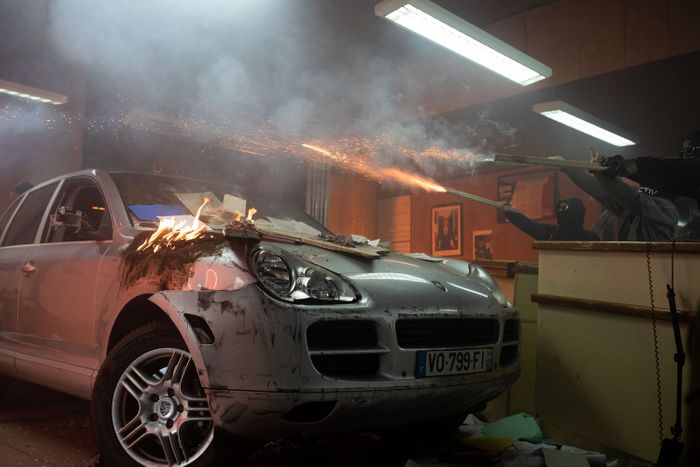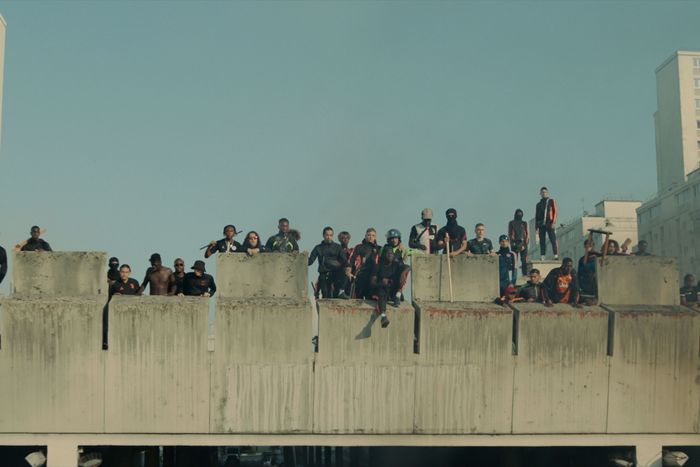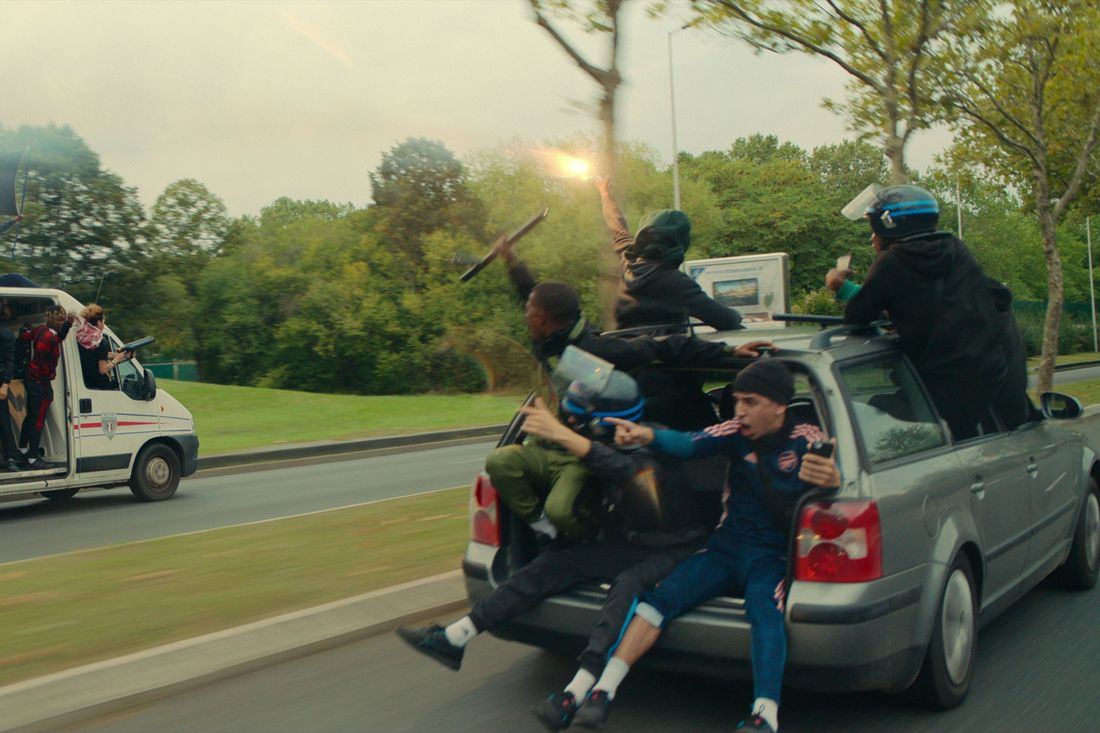
The most stunning scene of any movie this year was conceived partly as an attempt to beat your attention span. Athena, Romain Gavras’s riveting tale of a massive modern-day uprising at a French housing project, opens with one of the most impressive single shots ever put to film: an intense, unbroken 11-minute sequence that begins with a press conference outside a police station, plunges into the madness that erupts when a group of young people raid the station, and eventually ends a little over a mile away against the castlelike ramparts of a housing estate that has been taken over and fortified for an epic, inevitable clash with the cops.
The director wanted this opener to accomplish a number of important tasks: introduce his central characters, establish the grammar of the picture, and set up the location of the (fictional) Athena housing project where most of the movie takes place. But he also wanted to make sure he held the average streaming viewer’s attention. “It’s my first time doing a film for a platform and for Netflix in particular,” Gavras says. “And when we were writing with Ladj Ly” — who also produced — “we were thinking we needed to start really strong because even when I watch a Netflix film, if it’s not interesting in the first five minutes, I’m going to go away.” By contrast, he says, “when you do a cinema film, you can ease people in because they’re not going to leave after minute ten or 15.”
The rest of Athena is just as electrifying — filled with gloriously choreographed sequences of seemingly unbridled chaos — but filming those first 11 minutes took an almost supernatural degree of coordination and care. When Gavras first presented his longtime editor, Benjamin Weill, with the idea of building a movie out of long takes (or “sequence shots”), Weill objected. “At the beginning, he was like, ‘Cover yourself! Don’t do one-takes. Those are for losers or show-offs. It’s going to be annoying; you’re going to have so much dead air,’” Gavras recalls, laughing. But the director — whose influences for the film range from Mikhail Kalatozov’s I Am Cuba and Sergei Bondarchuk’s War and Peace to Star Wars and Citizen Kane — was determined because Athena is, at heart, a Greek tragedy about a group of brothers on opposing sides of a bloody war. That called for a certain unity of time and classical elegance as well as a fluid visual style that connects the characters to one another.
To deepen this sense of mythic grandeur, Gavras chose to shoot the film mostly in Imax digital using an Arri Alexa 65 camera, “which is like a fucking fridge,” he says. The size of the camera required a certain old-school steadiness to its movements, and amounted to a different relationship between foreground and background action and, thus, between a character and their environment. “Because the sensor is so big, the depth of field is different from normal cameras, so it kind of heroizes characters, if I can put it that way,” explains Gavras.
1. Rehearsals: Making the Dogville version.
The cast and crew rehearsed for five weeks before shooting. Cinematographer Matias Boucard says they effectively shot “a bad version” of the whole picture using handheld cameras, a handful of actors, and makeshift locations. (Gavras calls this “the Dogville version” of the movie, referring to Lars von Trier’s 2003 drama that uses chalk outlines on a darkened stage instead of locations.) For the actual production, they would be using tons background actors, most of them nonprofessionals cast from the Parc Aux Lievres housing projects where they shot. Many residents also worked crew jobs on the film.
“We trained them in acting and stunt work,” says first assistant director Amin Harfouch, who notes there was a team of professional stunt performers to help handle any scenes with physical contact. “The difficulty was to choreograph everything and make everything look as natural as possible, a perfect symbiosis of all the different trades: actors, extras, stunts, special effects, camera. The synergy had to be perfect. And for that, there is no secret — you have to rehearse, repeat and repeat again. Rigor and discipline were the key words.”
2. Two Crucial Close-ups: Meeting Abdel and Karim.
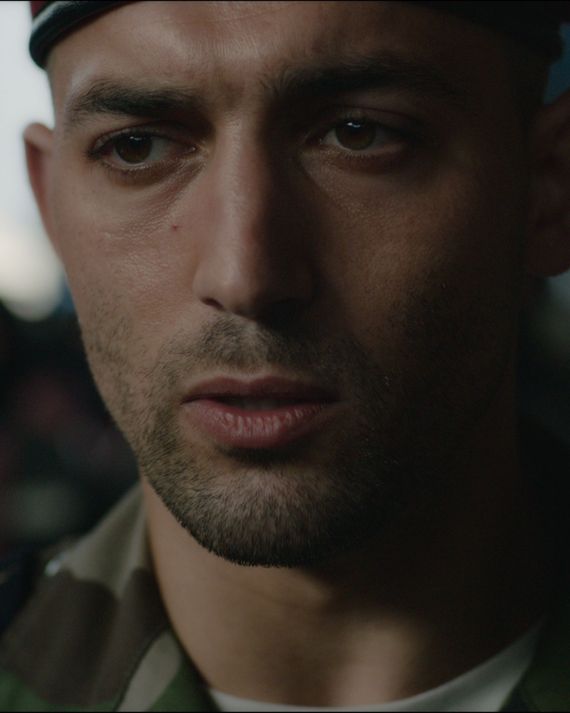
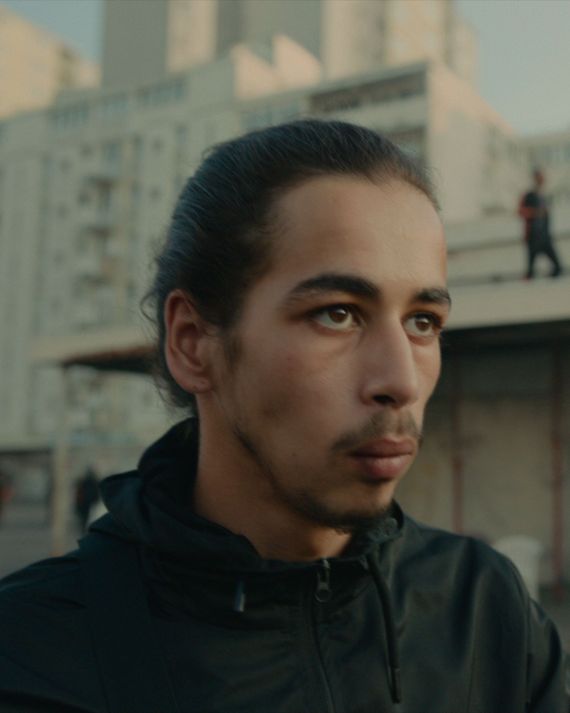
Athena begins with a close-up of Abdel (Dali Benssalah), a French soldier who has returned from service in Mali, announcing to the gathered press and public the death of his 13-year-old brother, Idir, who was a victim of police violence by unidentified cops captured on video. As Abdel asks for calm, the camera pans to the crowd watching him, then moves toward Karim (Sami Slimane), Abdel’s younger brother, who will soon be revealed as the leader of the group storming the station. It was crucial that the audience’s attention be immediately drawn to Karim. Thus, when the camera glides from Abdel to his brother, the focus changes immediately to ensure that our eyes land on Karim, even though at that point he’s just another face in the crowd. “We go from one brother to the other, but we also needed the distance between them,” says Boucard.
The camera, mounted on a Steadicam, approaches Karim slowly until we’re close to his haunted face. It pans down to reveal a Molotov cocktail being lit. Karim throws it and all hell breaks loose. The crowd gathered around Abdel begins to flee, and Karim’s black-clad army, their faces
covered, floods into the station. Amid the ruckus, the camera whips back to Abdel. While he looks around in shock, a car drives through the station doors in the background and the place becomes a full-on conflagration.
3. Behind the Seams: A car crash in layers.
In truth, an extremely long, unbroken sequence that moves from location to location and plunges in and out of scenes of crazy violence is rarely filmed as one actual shot but rather stitched together out of shorter elements (1917, Birdman, and even Alfred Hitchcock’s oneshot classic Rope all feature imperceptible cuts that maintain the illusion of a single uninterrupted take). Gavras won’t say exactly where his stitches are — “A magician’s not going to tell his tricks,” he
admits — but such cuts tend to come during fast pans or instances when a large figure (such as a passing actor or a column) briefly enters the frame and obscures some of the action. Often the deception is required for safety. It’s why, Boucard says, the car going into the station doors was achieved in layers: The camera movement was perfectly repeated first with the actors, then with the car, and the two resulting shots placed on top of each other during editing. The effect works so well because it’s a slightly blurry background action and doesn’t draw attention to itself – we’re still watching the actors.
Each character is shot differently. The camera focuses intently on Karim whenever he’s onscreen and tracks smoothly along with him, conveying his total control over his surroundings. (Gavras compares the character in these early scenes to Russell Crowe as Maximus in Ridley Scott’s Gladiator). For Abdel, however, who is desperate to quell the uprising and talk sense into his brother, the camera is far less steady, often roaming around him as if replicating his anxiety and confusion.
4. The Climax: The Athena youths’ blazing ride.
The emotional and technical high point of the entire sequence comes when the Athena youths, having commandeered a police van after the fiery mêlée at the station, speed down the highway, joyfully declaring victory and waving the French flag, as motorcycles pop triumphant wheelies all around them and bystanders along the road cheer them on. At first, the camera is inside the van, then it exits and follows the vehicle down the highway before reentering the van, exiting again, and spinning around it. The scene is eye-popping but never showy, because every movement feels motivated. There’s also, unbelievably, very little VFX or cutting. “I hate green screen,” Gavras says. “You don’t feel the danger.” Instead, the camera’s dive into the van and spiral around it were executed for real while hurtling down the road. A camera operator was strapped to a motorcycle driving alongside; as the vehicles continued, one camera operator, who was filming inside the van with the kids, handed the camera to the other operator outside, who then filmed the dizzying exterior shot of the van before handing it back to the crew inside the vehicle.
The crew rehearsed this specific scene repeatedly on an airport runway before shooting it. The movements had to be carefully choreographed not just because of the technical complexity but also for aesthetic intent: “Everything looks like a ballet,” Boucard says. “What you feel comes from the experience that you have with these young guys who are making a revolution — not really from the way that the camera moves.” Indeed, it’s a sublime, jubilant moment, but there’s an undercurrent of melancholy to it, which is punctuated by the music. As Gavras told his composer, Surkin (who also works with Gavras under the stage name Gener8ion), “We need to feel that they’ve won the battle, but we know they’re going to lose the war.”
5. The Location: Inside the Athena complex.
After arriving at the Athena projects (which Gavras considers another character in the movie), the camera enters the building and gives us small but key vignettes to establish the geography. We see Karim, who up until now has been the very picture of authority, turn into a polite puppy as he urges some of the older residents to stay in their homes. We also see Karim’s minions testing out the weaponry they’ve seized from the cops, including the riot guns and bulletproof vests. Gavras says he wanted to convey that these are still young people “and they’re going to have fun and do stupid shit.” But even this was, in essence, to further enhance Karim’s character and to balance “the seriousness of his drive” with the fact that “he is the head of an army that’s made up of kids.”
6. The Finale: Getting the drone shot
During the closing moments of this massive introduction, the camera, follows the resolute Karim and then pulls away from the overpass where he and his young comrades have gathered. For this, Gavras and his team added extensions to make the overpass look like the crenellated parapets of a medieval castle (and enhance the ageless quality of the film). One of these ramparts had to be able to swivel during the shot to make room for the camera to move past it. Here, a stitch was required because the camera itself had to change — from Imax to something lighter that could fit on a drone. That proved especially challenging. In order to seamlessly cut the two shots together, Boucard notes, they needed to make sure the light around them remained the same, which required a virtually instant changeover. The result is glorious: This shot that started in swirling tumult and close chaos now gives us a tensely still panorama of an army standing atop a fortress, waiting for the war to come to them.
And then the movie cuts.



